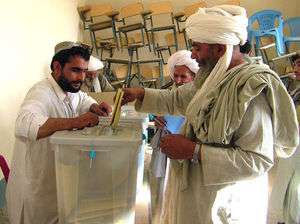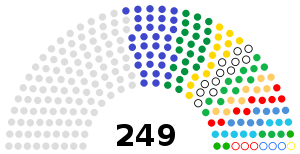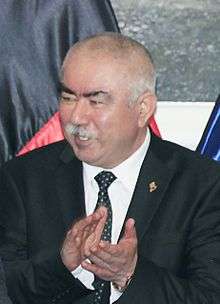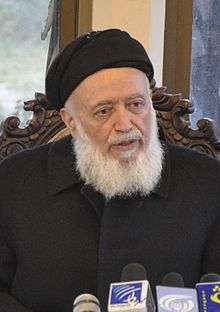2005 Afghan parliamentary election
Parliamentary elections were held in Afghanistan alongside provincial elections on 18 September 2005. Former warlords and their followers gained the majority of seats in both the lower house and the provincial council (which elects the members of the upper house). Women won 28% of the seats in the lower house, six more than the 25% guaranteed in the 2004 constitution.
| |||||||||||||||||
All 249 seats to the House of the People | |||||||||||||||||
|---|---|---|---|---|---|---|---|---|---|---|---|---|---|---|---|---|---|
| |||||||||||||||||
| |||||||||||||||||
 |
|---|
| This article is part of a series on the politics and government of Afghanistan |
|
Government Executive
Legislature
Judiciary |
|
Administrative divisions
|
|
|
Electoral system
Approximately twelve million voters were eligible to vote for the 249-seat Wolesi Jirga, the lower house of parliament, and 34 provincial councils. The 2,707 parliamentary candidates (328 female, 2,379 male) are all independent; parties are not recognized by law and lists do not exist. This has been the subject of criticism: relatively unknown people could win a seat as easily as very popular candidates. It has also made it considerably difficult for the population to decide whom to vote for, even though some candidates may be a member of or (financially) backed by a political party.
Another source of criticism is the use of the single, non-transferable vote in multi-member constituencies, particularly in the absence of party lists. In other words, each province elects a number of members, but each voter can vote for only one candidate. This runs the risk of fragmenting the vote to the point where candidates can be elected virtually by chance. Early returns confirmed this fear. For example, in Farah Province, one of the first provinces to declare its results, 46 candidates competed for five seats. No candidate polled more than 11%, and four of the five elected candidates polled less than 8%. In Kabul, which had 33 seats available, most of the candidates elected received well under 1% while over 30% of the votes cast went to three candidates, with the leading candidate receiving over 25 times the vote of the candidate elected with the lowest vote share, and several elected candidates receiving less than 2000 votes.[1] This creates the risk of a legislature in which the majority of members have little or no legitimacy.

Because a sizable percentage of the Afghan population is unable to read and write, all candidates had an icon as well. Those icons were included on the lists. These included, but were not limited to, pictures of footballs, cars or different sorts of flowers. Because there were not enough different icons, some candidates had multiple icons as their symbol: two or three footballs behind each other, like Gulallay Habib (page 16 of the Kabul parliament candidate list). For example, the candidate list for the Nuristan section of the parliament looked like this. Candidates were not able to choose the icons themselves: instead, the electoral committee chose them. Forty-five candidates were refused because of connections with armed groups or for not giving up their government jobs.
People vote for a candidate in their own province. Each province has a number of representatives in parliament, depending on the population. The largest province by population, Kabul, has 33 seats (390 candidates, 50 female, 340 male), whereas the small ones like Nuristan, Nimruz and Panjshir, have only two.
The total number of candidates for the provincial councils was 3,025. Each province, except Oruzgan, had women running for seats in the provincial council. Female candidates ran for parliament in all districts. District council elections, originally also scheduled for the same date, were not held in 2005 (district numbers, boundaries and population figures had to be determined first).
These were the first parliamentary elections in Afghanistan in 33 years: after communist rule, civil war and Taliban rule, the U.S. invasion of Afghanistan toppled the Taliban regime and after the presidential elections in 2004, parliamentary elections were organized in 2005. Originally, according to the 2001 Bonn agreement, the elections were to be held in June 2004. However, due to the security situation, Hamid Karzai (then interim President, now President of Afghanistan) moved the elections more than a year to the later date. Security was still an issue, as Taliban and others threatened to disrupt the elections violently. Several candidates were killed before polling.
A quarter of the seats - 68 seats - in the parliament are reserved for women, as well as 10 seats for the Kuchi community. Those are minimum numbers: there is no maximum for the number of seats for those groups. The 102 members of the Meshrano Jirga, the upper house, are indirectly elected by the provincial councils.
Conduct
During the 2009 Afghan elections, former U.S. Ambassador to Afghanistan Ronald E. Neumann recalled that the "indelible" ink used in the 2005 election to prevent people from voting more than once had turned out to be washable after all.[2] The same problem had also occurred in the 2004 presidential elections, and was repeated again in the 2009 elections.[3]
Results
Turnout was estimated at about 50%, substantially lower than at the presidential election in October 2004. This is blamed on the lack of identifiable party lists as a result of Afghanistan's new electoral law, which left voters in many cases unclear on who they were voting for. Turnout was highest in the Turkmen, Uzbek and the Tajik populated provinces in the north - generally over 60% - and 50% in some of the Pashtun southeastern areas where the Taliban insurgency is strongest. Turnout was also surprisingly low (34%) in the capital Kabul, which is dominated by Tajiks.
The first results were declared on 9 October, with final results being delayed by accusations of fraud, and were finally announced on 12 November. Only a minority of candidates contested the election on a party ticket, whilst a number of elected MPs were loosely associated with certain parties.
 | |||
| Party | Leader | Estimated seats | |
|---|---|---|---|
| Junbish | Abdul Rashid Dostum | 33 / 249 | |
| Jamiat-e Islami | Burhanuddin Rabbani | 22 / 249 | |
| Naveen | Yunus Qanuni | 13 / 249 | |
| Hezbe Eqtedar Milli | Sayed Ali Kazemi | 12 / 249 | |
| Hezbi Islami | Abdul Hadi Arghandiwal | 12 / 249 | |
| Dawat-e Islami | Abdul Rasul Sayyaf | 9 / 249 | |
| PIUPA | Mohammad Mohaqiq | 9 / 249 | |
| Mutahed-e Milli | Nur ul-Haq Ulumi | 8 / 249 | |
| Afghan Mellat | Anwar ul Haq Ahadi | 8 / 249 | |
| Hezbe Wahdat | Karim Khalili | 3 / 249 | |
| Mahaz-e Milli | Ishaq Gailani | 3 / 249 | |
| Harakat-e Islami | Sayed Hussein Anwari | 3 / 249 | |
| Nahzat Hambastagi-e Milli | Sayed Ishaq Gailani | 3 / 249 | |
| Paiwand-e Milli | Sayed Mansur Naderi | 1 / 249 | |
| Jamhorikhwahan | Sibghatullah Sanjar | 0 / 249 | |
| Source: National Democracy Institute, p.30 | |||
Elected members
| Name | Role | Constituency | Notes |
|---|---|---|---|
| Mohammad Younis Qanooni | Speaker | Kabul Province | Member of Afghan cabinet during the Afghan Interim Administration and Afghan Transitional Administration.[4] |
| Mirwais Yasini | First Deputy Speaker | Nangarhar Province | Candidate for President in 2009.[5][6] |
| Mohammad Arif Noorzai | First deputy speaker | Kandahar Province | Deputy speaker, related to President Hamid Karzai through marriage.[7] |
| Burhanuddin Rabbani | Badakshan Province | Former President of Afghanistan, leader of Islamic Society of Afghanistan | |
| Pacha Khan Zadran | Paktia Province | Signatory to Bonn Conference,[8] under suspicion of warlordism.[9] | |
| Saleh Mohammad Registani | Panjshir Province | Prominent anti-Taliban figure, who fought against the Taliban and Al-Qaeda during the resistance period in Afghanistan. | |
| Malalai Joya | Farah Province | Women's rights campaigner, nicked "the bravest woman in Afghanistan."[10][11] | |
| Sayed Mohmood Hasamuddeen Al-Gailani | Ghazni Province | Grandson of Pir Gailani, a prominent Sufi, and leader of an Afghan political party.[12] | |
| Ali Akbar Qasimi | Ghazni Province | General in the Afghan National Army, and was a former commander of the 14th Division, which was garrisoned in Ghazni.[12] | |
| Mohammad Daud Sultanzoy | Ghazni Province | Former pilot for United Airlines.[12] | |
| Niyaz Mohammad Amiri | Ghazni Province | Brother of Shah Mohammad and cousin of Hajji Fazell, Governors of two of Ghazni's districts.[12] | |
| Rahila Bibi Kobra Alamshahi | Ghazni Province | Teacher and journalist.[12] | |
| Zahera Ahmadyar Mawlayee | Ghazni Province | Formerly the head of the Ghazni women's shura.[12] She was a University Physics and Math instructor at a | |
| Shah Gul Rezai | Ghazni Province | Teacher from the Jaghoray district, prior to her election.[12] | |
| Abdul Qayyum Sajjadi | Ghazni Province | Editor of a science journal prior to taking office.[12] | |
| Khyal Mohammad Mohammad Khan | Ghazni Province | Financial chief for the Hezbi Islami, won by two votes.[12] | |
| Al-Haj Mamur Abdul Jabar Shulgari | Ghazni Province | Member of the Loya Jirga that drafted Afghanistan's new Constitution.[12] | |
| Abdul Bagi Baryal | Ghazni Province | Founded an organization for the disabled after he was blinded and lost a leg from a rocket during the Soviet occupation of Afghanistan.[12] | |
| Fauzia Gailani | Herat Province | Won more votes than any other female candidate,[13][14] or any other candidate in Herat.[13][14] | |
| Fazlullah Mojadeddi | Logar Province | Formerly Governor of Logar. Member of Wolesi Jirga from 2005-2010. Did not run in the 2010 Elections. | |
| Dr. Shakila Hashimi | Logar Province | Chairperson of the Health Committee | |
| Ali Mohammad | Logar Province | Sat on the Communications, Urban Development, Water, power, Municipal Affairs Committee | |
| Wali Wahdatyar Ahmadzai | Logar Province | ||
| Haji Akbar Stanekzai | Logar Province | ||
| Hajji Alam Gull Kuchi | Kuchi people | ||
| Shukria Barakzai | Kabul Province | Women's rights campaigner, journalist.[15][16][17] | |
| Malalai Shinwari | Kabul Province | Worked as a journalist prior to running for office,[18][19][20] reported that her supporters were subjected to intimidation from traditionalists, opposes selling daughters into marriage to pay off debts. | |
| Fauzia Nasryar Haidari | Kabul Province | ||
| Fatima Nazry | Kabul Province | ||
| Erfanullah Erfan | Kabul Province | ||
| Alami Balkhi | Kabul Province | Reported to be "associated with [Yunus] Qanuni's political faction."[21] | |
| Anwar Khan Auriakhel | Kabul Province | ||
| Baidar Zazai | Kabul Province | ||
| Abbas Noyan | Kabul Province | ||
| Jamil Karzai | Kabul Province | Second cousin to President Hamid Karzai, head of the National Youth Solidarity Party, sat on the Internal Security Committee.[21] | |
| Obaidullah | Kandahar Province | Served on the Economics committee.[7] | |
| Malali Ishaqzai | Kandahar Province | Served on the Government Services Committee.[7] | |
| Haji Ahmad Shah Khan Asakzai | Kandahar Province | Sat on the Armed Service Committee.[7] | |
| Haji Ameer Lali | Kandahar Province | Sat on the Armed Services Committee.[7] | |
| Fariba Ahmadi Kakar | Kandahar Province | Sat on the Armed Services Committee.[7] | |
| Habibullah Jan | Kandahar Province | Sat on the "Kandahar Security Shura",[7] reported to have been a "sometimes rival of [President] Karzai";[7] assassinated in 2008,[7] | |
| Khalid Pashtoon | Kandahar Province | Deputy chair of the Internal Security Committee.[7] | |
| Noorulhaq Olumi | Kandahar Province | Chair of the Armed Services Committee.[7] | |
| Shakiba Hashemi | Kandahar Province | Sat on the Environment Committee.[7] | |
| Sayyad Mohammad | Kandahar Province | Sat on the Armed Services Committee.[7] | |
| Amir Khan Sabri | Khost Province | Sat on the Communications Committee.[22] | |
| Mawlawi Hanif Shah al-Hussaini | Khost Province | Sat on the Justice Committee.[22] | |
| Sahira Sharif | Khost Province | Sat on the Education Committee.[22] | |
| Sayed Mohammad Gulabzoy | Khost Province | Sat on the Internal Security Committee.[22] | |
| Gul Haar Jalal | Kunar Province | Sat on the Disabled and Martyrs Committee.[23] | |
| Shujaul Mulik | Kunar Province | Sat on the Internal Security Committee.[23] | |
| Mawlawi Shahzada Shahid | Kunar Province | Sat on the Counter-narcotics committee.[23] | |
| Al-Haj Sahib Rahman | Kunar Province | Sat on the Economics Committee,[23] assassinated by a suicide bomber on November 6, 2007.[23] | |
| Sayed Durahman | Laghman Province | Former madrassa teacher.[24] | |
| Engineer Mohammad Alim Qarar | Laghman Province | Former commander with the Hezb-e-Islami Gulbuddin militia.[24] | |
| Zefnoon Safai | Laghman Province | Sat on the legislature's budget committee.[24] | |
| Esmatullah Muhabat | Laghman Province | Killed in 2005.[24] | |
| Mulla Abdul Salam Rakity | Zabul Province | Former Taliban commander,[25] sat on the Internal Security Committee.[25] | |
| Hameedullah Khan Tokhi | Zabul Province | Sat on the Internal Security Committee.[25] | |
| Toorpekai | Zabul Province | Sat on the Communications Committee.[25] | |
| Ahmad Waheed Khan Tahiri | Herat Province | ||
| Abdul Hadi Jamshidi | Herat Province | ||
| Abdul Salam Qazizada | Herat Province | ||
| Ahmad Behzad | Herat Province | ||
| Ahmad Waheed Khan Tahiri | Herat Province | ||
| Aqayee Jebraili | Herat Province | ||
| Aziz Ahmad Naadim | Herat Province | ||
| Gul Ahmad | Herat Province | ||
| Mohammad Arif Tayab | Herat Province | ||
| Mohammad Salih Saljoqi | Herat Province | ||
| Najla Dehqan Nizhad | Herat Province | ||
| Qazi Nazir Ahmad | Herat Province | ||
| Rahimi Jami | Herat Province | ||
| Saadat Fatahi | Herat Province | ||
| Sayyad Mohammad Shafiq | Herat Province | ||
| Shahnaz Hemati | Herat Province | ||
| Zarin | Herat Province | ||
| Fatima Aziz | Kunduz Province |
See also
- Enemies of Happiness, a documentary film shot during the election
References
| Wikimedia Commons has media related to Afghan parliamentary election, 2005. |
- Joint Electoral Management Body. Election results by province can be found here.
- Drei Frauen im afghanischen Wahlkampf, in: Neue Zürcher Zeitung, 15 September 2005
- Electionworld: elections in Afghanistan. Retrieved September 28, 2007.
- BBC Afghanistan election guide. Retrieved September 28, 2007.
- Candidate statistics. Retrieved September 28, 2007
- Radio Free Europe/azadiradio: Afghanistan Votes. Retrieved September 28, 2007
- Afghanistan: Old Problems, New Parliament, New Expectations U.S. Institute of Peace Briefing, October 2005. Retrieved September 28, 2007
- DefenseLINK News: Afghans Enjoy Successful Election Day
- http://d8680609.u106.forthost.com/province.asp?ProvinceID=1
- "Karzai and Warlords Mount Massive Vote Fraud Scheme". Archived from the original on 2010-05-24. Retrieved 2009-08-21.
- 'Indelible' ink used to mark Afghan voters may stain election success
- Thomas H. Johnson (February 2006). "The Prospects for Post-Conflict Afghanistan: A Call of the Sirens to the Country's Troubled Past". V (2). Strategic Insights. Archived from the original on 2009-03-01. Retrieved 2009-06-29.
- "Mohammad Younis Qanooni speaker of WJ meets Saudi Arabia's ambassador in Kabul". Government of Afghanistan. 2008-11-09. Retrieved 2009-05-25.
Also in the other part of session Mirwis Yasini first deputy of WJ presented the reports of the yesterday meeting with the country’s president about negotiation with Afghan Taliban and residence areas bombards, the non Consonance of foreign forces attacks with government organs and the lack of perspicuous systems justice and criminals penalty.
- Nancy A. Youssef (2009-07-07). "Where's Pentagon 'terrorism suspect'? Talking to Karzai". McClatchy News Service. Archived from the original on 2009-07-09. Retrieved 2009-07-08.
- "Profile: Kandahar Profile" (PDF). Navy Postgraduate School. January 2009. Archived from the original (PDF) on 2011-06-06.
- Kevin Sack, Craig Pyes (2006-09-26). "Cloak of secrecy hides abuse in Afghanistan". Seattle Times. Archived from the original on 2007-03-07. Retrieved 2007-10-22.
- "Armed Conflict Database: Afghanistan Timeline". International Institute for Strategic Studies. 2007-10-15. Retrieved 2007-10-22.
- "'The Bravest Woman in Afghanistan': Malalai Joya Speaks Out Against the Warlord-Controlled Afghan Government & U.S. Military Presence". Democracy Now!. 2007-06-19. Retrieved 2008-12-08.
- Afghanistan 2004 election results
- "Province: Ghazni" (PDF). Navy Postgraduate School. 2007. Archived from the original (PDF) on 2009-12-11.
- "Profile: Herat Profile" (PDF). Navy Postgraduate School. 2009.
-
Kim Barker (2005-11-06). "A conservative Afghan city elects a woman". Chicago Tribune. Retrieved 2010-06-13.
Her life started out much like those of other Herat women. At age 13, while she still played with dolls, she was forced to marry a man who was 15 years older. She was his second wife. But after moving to Iran during Afghanistan's wars, Gailani fell in love with sports. She started exercising and worked at a gym for women. When her family moved back to Herat after the Taliban fell, she brought two carloads of equipment to start gyms for women in Herat.
- Jason Staziuso (2009-03-03). "Afghan tech boom: Mullah embraces iPhone". Associated Press. Archived from the original on 2009-03-06. Retrieved 2009-03-04.
- Clancy Chassay (2008-11-22). "Acid attacks and rape: growing threat to women who oppose traditional order: Female MPs speak out as conditions worsen and Islamists gain respectability". The Guardian. Retrieved 2009-07-08.
- "The Media Report". Australian Broadcasting Corporation. 2006-06-22. Retrieved 2009-07-08.
- Alisa Tang (2007-07-10). "Afghan girls traded for debts, blood feuds". USA Today. Retrieved 2008-08-04.
- Golnaz Esfandiari (2005-08-12). "Threats, Intimidation Reported Against Female Candidates". Global Security. Retrieved 2008-08-04.
-
Abdul Baseer Saeed (2005-10-29). "Winning Afghan candidates become warlords' targets". RAWA. Retrieved 2008-08-04.
Malalai Shinwari, who came in first among Kabul's female candidates, said threats and intimidation have increased since her apparent victory. She blames the armed commanders who also appear to have won seats in the parliament with instigating the violence in their own political interests.
- "Profile: Kabul Profile" (PDF). Navy Postgraduate School. 2009. Archived from the original (PDF) on 2010-06-11. Retrieved 2010-06-15.
- "Profile: Khost Profile". Navy Postgraduate School. January 2009. Archived from the original on 2010-06-19.
- "Profile: Kunar Profile" (PDF). Navy Postgraduate School. 2009. Retrieved 2010-06-14.
- "Program for Culture and Conflict Studies: Laghman Province" (PDF). Naval Postgraduate School. Retrieved 2008-05-30.
- "Profile: Zabul Profile". Navy Postgraduate School. 2009. Archived from the original on 2010-06-19. Retrieved 2010-06-15.

